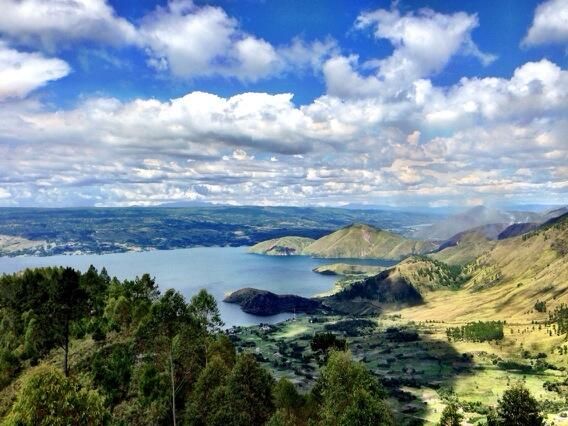The Lesson of Lake Toba
By Seth Baum | October 21, 2014

On the Indonesian island of Sumatra, there is a large lake that used to be a mountain. How is it that a mountain becomes a lake? Simple: It erupts. This mountain on Sumatra unleashed an utterly massive volcano eruption 75,000 years ago. For perspective, it was the largest eruption in the last 25 million years. And so today, Sumatra has the beautiful Lake Toba instead of a Mount Toba.
The Toba eruption may have been the greatest catastrophe in human history. It occurred toward the beginning of the most recent ice age. Ash from the eruption blocked incoming sunlight, causing temperatures to plummet. Living conditions likely became extremely harsh. Some scientists have proposed that the eruption caused a sharp decline in the human population, perhaps to as few as 4,000 people. The human species may have teetered on the edge of extinction.
Think about all that’s happened in the last 75,000 years. Thousands of generations, billions and billions of people, have lived since then. The agricultural revolution began only about 10,000 years ago, the industrial revolution 250. People today have lives that would be completely inconceivable to the people alive 75,000 years ago. Yet, those people are our ancestors. Without them, none of this would have ever happened. Without them, we would not be here today. We owe our existence to our distant ancestors surviving the Toba eruption.
Nobody today knows what it took to remain alive after Toba. Archaeological evidence is scarce and inconclusive. There may not have even been a significant population decline. What we do know is that we’re glad that our ancestors did whatever it took to survive. However difficult the conditions were, we’re glad they persevered. From our 21st century perspective, survival as a species is by far the most important thing they could have done with their collective lives.
Flash forward to the future, 75,000 years beyond today. If we know little about our distant ancestors, we know even less about our distant descendants—how numerous they will be, what their lives will be like, what they will care about. What new revolutions will change the world between now and then? What technology, what culture, what conditions will shape and inspire their lives? Today, we can only speculate. But we can be confident about one key thing: Just as we value our own existence, so too will they.
This is the lesson of Lake Toba. Regardless of what else happens, the human species must stay alive. This is the most important thing that people today can do with their lives.
Fortunately, massive volcano eruptions are extremely rare. So too are other major threats from nature, such as large asteroids and comets colliding with Earth. These threats are serious enough to warrant some attention, but they are not the most serious threats that humanity now faces. Readers of the Bulletin are familiar with some of these more likely existential threats, such as large-scale nuclear and biological warfare, global warming, and pandemic disease outbreaks. Researchers in the field also worry about the dangers posed by certain emerging technologies in artificial intelligence, biotechnology, and nanotechnology. These threats can be every bit as destructive as supervolcano eruptions or large asteroid or comet collisions, but they are much more likely to happen, and thus more important to focus on.
But the threats themselves are ultimately less important than what people can do, individually or collectively, to address them. A threat can be large or small, likely or unlikely, imminent or distant, and so on, but none of those considerations matters much if humans are not going to respond in some way. For comparison, our distant ancestors could have been masters of volcano science, but all their volcano expertise would have been for nothing, if they did not use their knowledge to help them survive. Likewise, society today should avoid the temptation to get caught up in the threats themselves and should instead focus on solutions.
A classic case of what not to do is the film An Inconvenient Truth. It spends an hour and a half chronicling the problem of global warming with only a brief passing mention of what to do about it tacked on at the very end. This is unfortunate. An understanding of global warming on its own does not solve the problem. Furthermore, many important solutions can proceed without understanding the problem. For example, energy efficiency saves money, and vegetarian diets are in many ways healthier than the meat-heavy diets that contribute a lot more to global warming. Had the film emphasized the solutions and all their merits, there might be less greenhouse gas in the atmosphere right now.
But at least An Inconvenient Truth focused on the right type of problem. Too much of what society does today revolves around smaller issues that will be irrelevant 75,000 years from now, when more could be done to confront the major threats to humanity’s survival. To be clear, the major threats are not being ignored. To the contrary, quite a lot is being done. But more can and should be done. Until these threats are eliminated, they should be society’s top priority. In the long run, little else matters.
Together, we make the world safer.
The Bulletin elevates expert voices above the noise. But as an independent nonprofit organization, our operations depend on the support of readers like you. Help us continue to deliver quality journalism that holds leaders accountable. Your support of our work at any level is important. In return, we promise our coverage will be understandable, influential, vigilant, solution-oriented, and fair-minded. Together we can make a difference.















